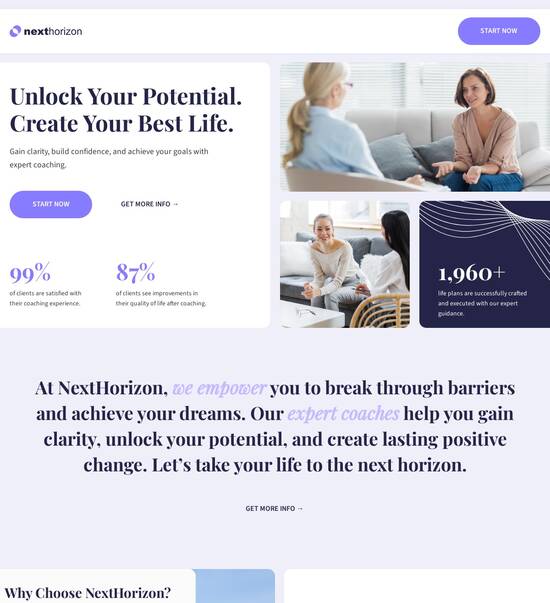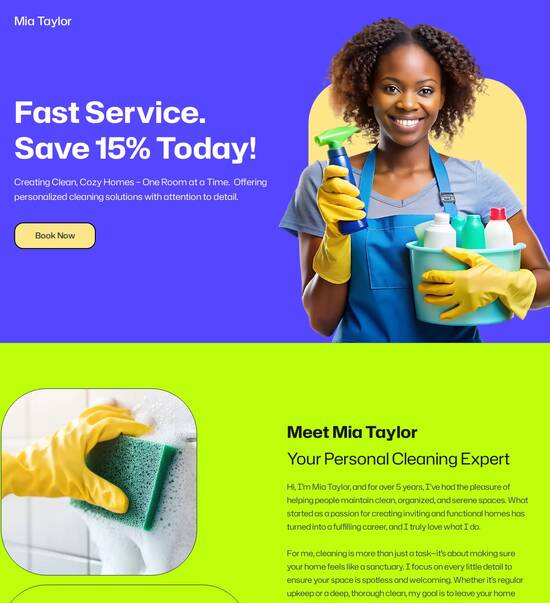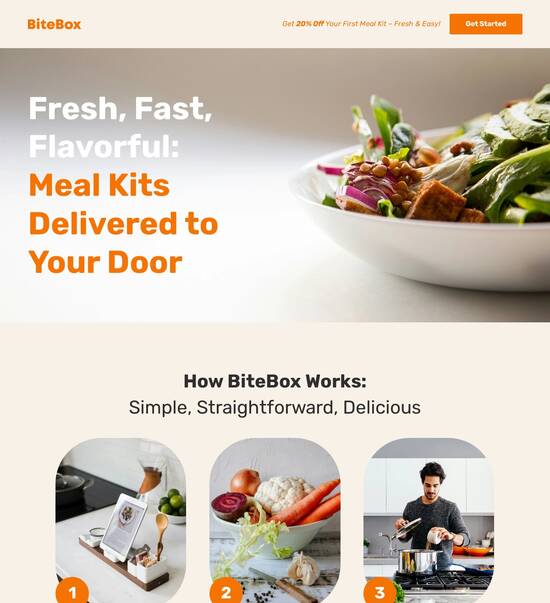
HTML page template for steel companies
Use TemplateAbout template
Give your steel companies a boost with our professional landing page templates. Ready to turn visitors into customers?
Recommended templates

Easy to build without coding
With the intuitive drag-and-drop builder, anyone on your team can create high-converting pages without any knowledge of code or design. Make enhancements to your landing page with custom widgets using Javascript, HTML/CSS, or third-party scripts.

Multiple layouts for any industry and goal
Select from 500+ landing page layouts built to boost conversions across industry-specific scenarios. Customize them by adjusting fonts, adding images, and generating on-brand content with the AI assistant. Quickly scale with Instablocks® and Global Blocks that you can save, reuse, and update globally.

Loads fast and looks polished on any device
Every template is responsive, which means they present professionally on any device and load blazingly fast with our Thor Render Engine. You can also power them up with Google AMP technology to deliver an unparalleled mobile experience and drive higher conversions.

Robust analytics & experimentation
Get real-time updates and reporting across all your devices, showing the number of visitors, conversions, cost-per-visitor, and cost-per-lead. Launch AI-powered experiments, run A/B tests, and use heatmaps to analyze user behavior, then optimize your landing page to maximize conversions.







Easy to build without coding
With the intuitive drag-and-drop builder, anyone on your team can create high-converting pages without any knowledge of code or design. Make enhancements to your landing page with custom widgets using Javascript, HTML/CSS, or third-party scripts.
Multiple layouts for any industry and goal
Select from 500+ landing page layouts built to boost conversions across industry-specific scenarios. Customize them by adjusting fonts, adding images, and generating on-brand content with the AI assistant. Quickly scale with Instablocks® and Global Blocks that you can save, reuse, and update globally.
Loads fast and looks polished on any device
Every template is responsive, which means they present professionally on any device and load blazingly fast with our Thor Render Engine.
Robust analytics & experimentation
Get real-time updates and reporting across all your devices, showing the number of visitors, conversions, cost-per-visitor, and cost-per-lead. Launch AI-powered experiments, run A/B tests, and use heatmaps to analyze user behavior, then optimize your landing page to maximize conversions.
All the features you need to build lead-generating landing pages
Explore more featuresLearn how to build top-performing landing pages for any goal
FAQs
Leading the way in building high-performing landing pages





A powerful guide to using Instapage for marketing success
In the competitive landscape of digital marketing, leveraging Instapage can give your business the edge it needs. With its robust landing page and conversion rate optimization (CRO) features, Instapage is designed to help marketers across various sectors such as business services, education, and financial services achieve maximum ROI on their campaigns. This guide provides a step-by-step approach to harnessing the full potential of Instapage.
Understanding Instapage: The ultimate landing page solution
Instapage is an all-in-one platform that empowers marketers to create high-converting landing pages without requiring coding skills. With over 100 customizable templates, users can easily build and optimize pages for different audiences. Marketers from various industries, including tech, education, and government, will find that Instapage addresses their unique needs while enhancing conversion potential.
- Access a wide range of high-converting templates that are ready to use.
- Utilize intuitive builders that simplify the page creation process.
- Take advantage of pre-built lead generation elements for effective contact capture.
Step 1: Crafting your landing page with Instapage
Creating a captivating landing page is crucial for effective lead generation. Start by selecting a template that aligns with your campaign goals. Customize it using Instablocks, which allows for quick modifications without coding.
- Select a template: Choose from a library of conversion-focused layouts to fit your brand.
- Customize elements: Use the drag-and-drop builder to adjust images, copy, and calls-to-action.
- Preview and publish: Ensure your page looks perfect on all devices before going live.
Step 2: Optimize for audience engagement
To ensure your landing page converts effectively, employ Instapage's optimization features. Understanding user behavior through heatmaps can highlight areas that need adjustments.
- Conduct A/B testing: Experiment with different headlines, images, and CTAs to identify what resonates best with your audience.
- Use heatmaps: Analyze where users click most frequently to enhance user experience.
- Track analytics: Leverage the analytics dashboard to review performance metrics and make data-driven changes.
Step 3: Collaborate and iterate for improvement
Fast-track the page creation process by utilizing Instapage's collaboration features. Engaging with your team members can lead to more innovative and refined landing pages.
By gathering feedback in real time and making direct edits, you can ensure every element aligns with your marketing strategy.
Ready to boost your digital marketing strategy? Start exploring Instapage today and experience enhanced ROI through expertly crafted landing pages tailored to your audience's needs.
HTML Page Template for Steel Companies: A Comprehensive Guide
Understanding the essential elements of an HTML page template for steel companies
In the steel industry, having a professional online presence is vital for effective communication and engagement with clients. An HTML page template serves as a foundational framework for steel companies looking to establish or enhance their websites. It comprises pre-designed layout structures built with HTML, providing essential elements such as headers, footers, navigation bars, and content sections. Using these templates can streamline web development processes, allowing businesses to focus on presenting their products and services effectively.
Beyond aesthetics, HTML templates play a crucial role in branding and accessibility. They help steel companies present their corporate identity while ensuring that the information is easily navigable. This is particularly significant in an industry where complex product specifications and processes must be conveyed clearly to potential clients. Thus, it's critical to understand the components of these templates to leverage them effectively.
Functional aspects of HTML page templates
HTML page templates must be designed with functionality in mind. The integral elements include optimized navigation, clear call-to-action buttons, and responsive design that adjusts seamlessly across devices. These functionalities not only support user experience but also enhance the interaction between clients and the steel company.
Effective integration of forms for inquiries or quotes can significantly facilitate communication, while embedded maps can indicate locations and manufacturing facilities. Moreover, tailoring the user interface to accommodate features like filters or sorting mechanisms helps users easily find relevant products and specifications, ensuring that the browsing experience is both enjoyable and efficient.
Browser compatibility for steel company websites
Cross-browser compatibility is paramount for any website, including those of steel companies. Ensuring that your HTML page template performs optimally across various web browsers—such as Chrome, Firefox, Safari, and Edge—helps in reaching a broader audience. Discrepancies in rendering can lead to user frustration and potential loss of clientele.
To achieve this, developers should employ tools like BrowserStack or CrossBrowserTesting that simulate how a webpage appears on different browsers and devices. Regular updates and adherence to web standards (like W3C) are essential practices for maintaining compatibility and improving performance. Utilizing CSS resets and flexible design methods, such as CSS Grid and Flexbox, can also aid in achieving design uniformity, further enhancing compatibility.
Engaging multimedia elements
Incorporating video into HTML page templates can significantly enhance a steel company’s ability to showcase its products and processes. Videos can illustrate complex manufacturing techniques or highlight product benefits, making them a valuable tool for communication. High-quality, well-edited video content can lead to improved understanding and engagement from potential clients.
To embed videos effectively within your template, utilize platforms like YouTube or Vimeo that provide responsive embed codes. Also, consider the placement of videos; positioning them below product descriptions or as part of a featured section can draw attention without overwhelming visitors. Providing captions or supplementary text can further aid in accessibility and comprehension.
The power of color schemes
Choosing a color palette that reflects the steel industry's core values—strength, reliability, and innovation—can influence user perception dramatically. Colors like blue, gray, and metallic shades can reinforce these values while fostering a sense of professionalism. It’s also important to consider the psychological effects that colors can have on visitors, as colors can evoke emotions and perceptions.
For instance, a blue-gray scheme might reflect trust and stability, while splashes of brighter colors like orange may indicate innovation and creativity. Recommended combinations might include navy blue paired with a lighter gray for a classic look, or introducing orange as an accent to breathe vitality into the site. Consistency in your color usage throughout the website is essential for maintaining brand identity.
Typography and font choices
The choice of fonts in an HTML page template is crucial for conveying professionalism and reliability in the steel sector. Fonts should be easily readable, particularly when presenting technical specifications. San-serif fonts like Arial, Helvetica, or Roboto are often preferred for body text, while more traditional serif fonts can be utilized for headings to signify authority.
Maintaining consistency in typography across your web pages is vital for creating a cohesive look. Establishing a hierarchy—where headings, subheadings, and body text have distinct styles—provides visual guidance and enhances readability. Use font weights and sizes strategically to draw attention to important sections, ensuring that the content resonates with both technical and non-technical audiences.
Structuring the header for maximum impact
The header is one of the most important parts of your HTML page template. Essential elements to include are the company logo, navigation links, and contact information. Designing an intuitive header not only ensures brand visibility but also enhances usability by allowing visitors quick access to vital sections of the site.
Best practices for header design involve keeping it clean and uncluttered. Using sticky headers that remain visible while scrolling can improve navigation, and ensuring that links are descriptive will help with search engine optimization. Consider incorporating a search bar for direct access to specific information, which is particularly useful in an industry like steel where product catalogs can be extensive.
Designing an effective footer
A well-designed footer balances aesthetics with functionality, serving as a hub for additional information that visitors might seek. Key components to include are company information, social media links, and a sitemap, which can help users navigate through the site even after they've scrolled to the bottom of the page.
Maximizing the footer's effectiveness can involve strategies such as incorporating secondary navigation and establishing clear groupings of links. A subscription form for newsletters or key contact information, like a phone number or customer service email, can also encourage further engagement without displacing essential information. Considering the footer as an extension of your brand will ensure it supports user needs.
The role of columns in information layout
Using columns in HTML page templates can greatly enhance how information is organized and presented. Multi-column layouts can break down overwhelming amounts of technical data into digestible segments, allowing users to process information more efficiently. This is particularly effective when detailing specifications or comparisons between products.
Implementing a structured column layout requires consideration of alignment and spacing. It’s essential to ensure that each column is balanced, and that the flow of narrative from one to another feels natural. Use visual cues, such as headers or contrasting colors to distinguish between sections, promoting an engaging narrative flow.
Creative and functional layout options
Choosing a suitable layout style for your steel company's website can have a significant impact on user engagement. Several popular options include grid layouts, card layouts, and fluid designs. Each of these styles offers unique advantages tailored to displaying various types of content effectively.
For instance, grid layouts allow for organized presentation of product catalogs, while card layouts can showcase individual items with accompanying descriptions and actions. Fluid designs are optimal for a responsive experience, ensuring that users can access your site on any device. Let's not overlook the value of using modular layouts, which create visual rhythm and enhance interaction without overwhelming the visitor.
Incorporating design elements for visual appeal
To enhance user interaction, HTML page templates should incorporate design elements such as buttons, icons, and separators. These elements contribute not just to aesthetics, but also to guiding users through their journey on the site. However, housekeeping in design is vital, as overcrowding can lead to visual clutter and confusion.
Best practices involve employing minimalist design principles, where each element serves a clear purpose. Use buttons that are distinct and action-oriented, and consider employing hover effects that provide physical feedback when users interact with elements. Additionally, strategic use of icons can help convey messages clearly—and recognizing accessibility in color usage ensures that all visitors can engage with your content.
Crafting compelling content that resonates
For steel companies, it’s essential that web content reflects industry values such as integrity, quality, and innovation. Compelling content should articulate the benefits of products and services while also infusing technical specifications in a way that is accessible to a wider audience. Focusing on clear, concise language helps avoid overwhelming technical jargon.
Incorporating storytelling into content can significantly enhance the emotional connection with visitors. Share case studies that highlight successful partnerships or projects, explaining how your company’s steel products solved specific problems. Additionally, including customer testimonials adds credibility and trust, further making a strong case for why potential clients should engage with your steel company.
Leveraging visuals: choosing the right images
Images play a crucial role in conveying the essence of steel products and reinforcing brand identity. When selecting visuals, prioritize high-quality images that resonate with your target audience. Types of images should include product shots, manufacturing processes, and applications in various industries—that way visitors can visualize how these products impact different markets.
Guidelines for sourcing images involve choosing stock images or working with professional photographers for custom content. Moreover, optimizing images for the web is essential; this means balancing high quality with fast loading times, thereby ensuring that visitors do not leave due to slow site performance. Striking a balance between aesthetic appeal and practicality will enhance overall user experience.
Understanding the DOMContentLoaded event
The DOMContentLoaded event is a crucial concept when optimizing your HTML page template. This event signifies that the initial HTML document has been completely loaded and parsed without waiting for stylesheets, images, and subframes to finish loading. Harnessing this event effectively can lead to better resource loading strategies, thereby improving user satisfaction.
To leverage this event, consider deferring non-essential scripts until after the DOMContentLoaded event fires. This will enable users to interact with the content sooner, minimizing perceived load time. Furthermore, ensuring that critical resources are loaded primarily helps to boost performance during the critical rendering path, directly enhancing user experience on your steel company website.
Common problems in template usage and solutions
HTML page templates can pose challenges for steel companies if not implemented correctly. Potential issues include poor responsiveness across devices, broken links, and slow load times, which can hinder customer engagement. Identifying these problems is the first step toward creating a seamless user experience.
To troubleshoot, employ consistent testing across multiple devices and browsers to catch rendering issues early. Regular updates and maintenance of the HTML structure will help mitigate the effects of broken links. Incorporating performance monitoring tools such as Google PageSpeed Insights can provide valuable feedback on ways to enhance site speed, which is crucial for retaining visitors.
Utilizing the download panel for user engagement
Providing downloadable resources is an excellent strategy for user engagement and lead generation. Whether it’s brochures, product data sheets, or case studies, offering these materials in a structured download panel can drive interest while also gathering potential leads. This interaction fosters a sense of value for visitors looking to delve deeper into your offerings.
Best practices for presenting a download panel involve keeping it visible yet unobtrusive. Clear labels and concise descriptions will guide users to the resources they need without overwhelming them. Additionally, consider requiring users to fill out a simple form before downloading; this aids the steel company in building a contact database for future marketing campaigns.
The advantages of an HTML builder for customization
HTML builders offer steel companies an accessible way to create and customize templates without extensive coding knowledge. These platforms, such as Instapage, provide user-friendly environments where marketers can build landing pages quickly, utilizing a library of conversion-focused layouts and design elements.
Key features such as drag-and-drop functionality, responsive design templates, and pre-designed blocks facilitate easier customization. By employing these tools, steel companies can create unique pages tailored to their branding needs without the necessity of a developer. Furthermore, ongoing updates and advanced optimization tools empower teams to create high-performing pages that align with their target marketing goals.
Future considerations for steel company websites
Looking ahead, steel companies should be attuned to anticipated web design trends, including the growing focus on mobile responsiveness and user-centric design. As technology continues to evolve, incorporating artificial intelligence for personalized experiences could become a norm. Adapting HTML templates to cater to these trends will be paramount for sustaining competitive edge.
Furthermore, staying informed about advancements in web technologies, such as progressive web apps (PWAs) and enhanced security features, will shape how websites are structured. Preparing for these future developments entails building HTML templates that are flexible and easily adaptable, thus allowing steel companies to respond to market shifts swiftly.
Conclusion: transforming steel companies' online presence
A well-crafted HTML page template is instrumental for steel companies aiming to elevate their online presence. By incorporating the elements discussed, steel businesses can foster user engagement, facilitate effective communication, and enhance brand visibility. Continuous improvement in web practices, from optimizing multimedia content to ensuring responsive designs, is integral to captivating the modern digital user.
As the landscape of web design evolves, so too must the strategies employed by steel companies, ensuring they meet the needs of their technology-savvy clientele. Investing time and resources into developing effective HTML page templates will yield significant returns in terms of client engagement and brand loyalty.
Ready to skyrocket conversions?
Supercharge your ad campaigns with high-performing landing pages
Get started














